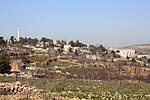Battle of Beth Zechariah
162 BC2nd century BC in the Seleucid EmpireBattles of the Maccabean RevoltJudas Maccabeus

The Battle of Beth Zechariah was a battle around May 162 BC during the Maccabean revolt fought between Jewish rebels under the leadership of Judas Maccabeus (Judah Maccabee) against an army of the Seleucid Empire, the Greek successor state (diadochi) to the Macedonian conquests that controlled Syria and Babylonia. The battle was fought at Beth Zechariah (modern Khirbet Beit Zakariyyah) and was a Seleucid victory, with the rebels driven from the field in retreat. Judas's brother Eleazar Avaran died in combat with a war elephant. The defeat allowed the Seleucids to continue their campaign and besiege the Jewish holy city of Jerusalem.
Excerpt from the Wikipedia article Battle of Beth Zechariah (License: CC BY-SA 3.0, Authors, Images).Battle of Beth Zechariah
Beitar Ilit
Geographical coordinates (GPS) Address Nearby Places Show on map
Geographical coordinates (GPS)
| Latitude | Longitude |
|---|---|
| N 31.664 ° | E 35.12325 ° |
Address
Beitar Ilit
Judea and Samaria, Palestinian Territories
Open on Google Maps








